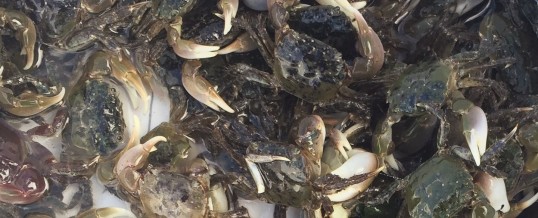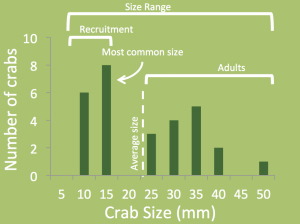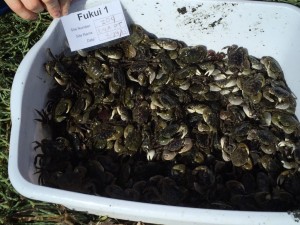
One strength of the Crab Team protocol is that it enables us to confidently compare findings among different sites, and track changes over time – even if different people are doing the sampling. With sampling on this scale, even the small steps can be important to what we learn from the data. The Protocol in Focus will allow us to expand on these details, and offer an opportunity to see all the behind-the-scenes planning that goes into methodology!
Almost every volunteer has had the question: When we measure crab size, what do you mean by selecting crabs haphazardly, and how do I manage that with a bucket full of angry HEOR? And why does it matter?

Sample data showing what can be learned by measuring the sizes for crabs.
The way we select crabs has a strong influence on what we learn from the sampling. The goal of measuring crabs is to get an estimate of how large the entire population of each species is, in terms of carapace width, and not just the average size, but also the range of sizes, and the most common size. We can also tell something about the age of the population, based on size. For instance if we graph the number of crabs of each size (below) and see two humps, we might infer that there is more than one age group of crabs, and that the clump of crabs that are smaller represents a big recent influx of baby crabs – a recruitment pulse. We can watch that group grow over the course of the summer too – pretty cool!
There are a number of ways we can figure out the shape of the humps and clumps of crab sizes, we can either measure every single crab in the trap, or we can sample some smaller number of crabs, and then estimate the humps and bumps. With some traps, we can easily measure every single individual, but many traps have hundreds of HEOR (the current record is nearly 500), so sub-sampling is a much more practical way to go. However, it’s not always straightforward to decide the best way to choose which of the crabs in each trap to measure so that we get a ‘representative sample’.
Clearly, only choosing the largest or smallest crabs to measure would give you an inaccurate estimation of the actual size of crabs. It’s tempting to correct for this by alternating between the biggest and smallest crabs: you might end up closer to the true average, and you’ll get the correct range, but you won’t be able to accurately estimate how common each size is, and a site might look like it has two humps, even though it only has one!
The best solution is to try to get as close to random as possible, meaning that every crab in the trap has an equal probability of being chosen, and the process by which they are selected is mathematically random. Why don’t we just say: “Choose randomly” then? It turns out that humans are very poor randomizers. We are just too good at categorizing, and organizing, and labeling things in our heads. So, we have to use some truly random process when we say we are sampling randomly. Often this is done with a random number generator (as we have done with the quadrat distances along the transects each month).

It would have been hard to predict just how many hairy shore crabs we were going to capture at Kala Lagoon!
This gets very tricky when you are looking at a bin full of crabs; to sample with true randomness, every individual has to have an equal probability of being one of the crabs selected to be measured, but we would have to know the number of crabs in the bin to figure out how to assign that probability, which is impossible to do in advance with trapping. One suggestion is to flip a coin for each successive crab you pull from a trap, heads you measure the crab, tails you don’t. The coin flip is a random process, so that should do it, right? The coin flip itself is random, but it doesn’t result in an equal chance of being measured for every single crab. Remember that you only measure 10 males and 10 females, so the first crab you pull out will have a 50:50 chance of being measured (heads). However, if you have 300 crabs in your bin, what do you think is the chance that you will make it through all 300 coin flips, and still need to measure a crab? That last crab has an extremely small probability of being measured, which is why that is not truly random sampling.
In situations like this, which are very common in field ecology, the best practice is to sample “haphazardly”, acknowledging that you are not being mathematically random, but attempting to remove as much human and crab bias as is reasonable. Many volunteers have observed that crabs sort themselves at the edges of the bin, often with the largest crabs on top. The best way to be haphazard, then, is to gently shuffle the crabs around in the bin (reducing crab bias), and look away (reducing human bias) before selecting one to measure. We don’t recommend doing this with a bucket full of adult Dungeness or rock crabs (if you get a bucket full of those crabs, we might want to move your site!), but most of our traps are filled with small HEOR, where a pair of gloves and nimble fingers should shield you from too much anguish.
Admittedly, it’s not a perfect solution, but we think this strategy finds the sweet spot between rigor and practicality. Field ecologists do this constantly when protocol that was carefully planned out while drinking coffee, sitting at in warm, dry, office, turn out to be completely intractable while being chased off a mudflat by the returning tide and sideways rain. What were we thinking?! But we also strive to anticipate and build this balance into our protocol, knowing that every volunteer will have different experience, skills, and approaches.
Thanks for all the great questions and ideas. Please keep them coming, it helps us strengthen our monitoring and training to have your feedback and questions. Check out our FAQ in the Volunteer Toolbox on the Crab Team website for more protocol questions.
Return to News page.
Return to Crab Team home page.
Follow @WAGreenCrab
JAN
2016